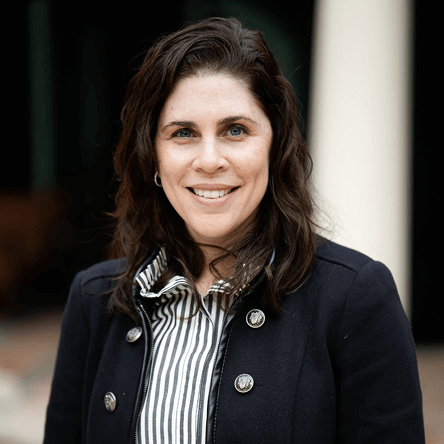I was at the orthopedist’s office. I had pain in my hands, upper body, and neck, and had been wearing wrist braces for the last few weeks. As I waited for the doctor, I suddenly became light-headed and dizzy and rushed into another patient’s room, blurting out, “I’m going to pass out.” The doctor and patient looked at me like I was crazy, and the doctor told me to return to my room. I did so, lying down on the examination table and breathing deeply, recognizing I was having a panic attack.
As I waited for the doctor, I thought: Something must change.
The doctor, a hand specialist, came into my room about ten minutes later. I had gathered myself by then. He couldn’t address my torso and back pain, but he told me I had repetitive stress injury and that I needed to take it easy. He recommended I stay home from work for two weeks.
I took the next two days off, but as those of us in the classroom know, a teacher taking off two full weeks of work in the middle of a semester isn’t truly feasible. In fact, when I floated the idea to my principal, he looked displeased, and I was back at work after my two-day hiatus.
Prior to my breakdown, I had complained about work demands. The faculty had recently finished writing individual emails to all of our parents, as a mid-quarter update on their children’s progress. I had pushed back saying I was handling a full course load of English classes, which all required heavy paper grading and which I was doing on the computer, having set up a learning management system I was then trying out (all schools were not yet on LMSes; I was learning how to use one on my own). I’d also been experimenting with a class blog, to try blended learning in a history class I was teaching. My other school duties included overseeing the English department and an interdisciplinary program, and running a new, experimental, progressive education program. The school had also assigned a group of student mentees to me.
When I received the mandate to write the emails, I’d already been feeling overwhelmed, and the school year had barely been underway. I tried ineffectively to raise an alarm, to say I couldn’t cope with all I was doing, but I was unsuccessful. Finally, my body stopped working properly, and my pain and panic attack communicated clearly that I had to make some changes in my life.
• • •
For the last 15 years, with the emphasis schools have rightly placed on learning new technologies and pedagogies, teachers have had to keep up with a mind-spinning number of new initiatives, with the result being that the field of Jewish education has become professionalized in impressive ways. The standard of education and the kind of care students get in Jewish day schools have improved exponentially, and we have much to be proud of.
The problem that no one was talking about was the toll that learning these educational innovations was taking on teachers. It was no wonder that I had pushed myself to try so many new initiatives at once; there had been much external and internal pressure to perform, but there’d been no one telling me how or even that I had to prioritize.
When I became general studies principal of another school, I tried not to overwhelm teachers with many new initiatives at once, but I also understood that I was already in a system that was doing so. I watched as some teachers left after one year of my principalship; I sensed they felt overburdened by the one initiative I felt most passionately about, project-based learning. Though I had tried to mitigate the effects of implementing it, I knew that it did take much training, and for someone who wanted to teach in a more traditional way, learning the pedagogy would be overtaxing.
Meanwhile, on social media, I kept seeing open letters (mainly from public school teachers) announcing their resignations and cataloging the reasons they were leaving the field: none of them complained about their students, no matter how challenging they were. Instead, they talked about being overburdened by demands on their time while at the same time being underpaid. These teachers shared that they took money out of their own pockets to pay for classroom supplies, and also described how they had to hold down two or three jobs in order to simply be able to afford to teach. When the bureaucratic demands of their jobs became too great, they finally broke. As much as they loved working with children, the toll that teaching took on their lives – the fact that it didn’t give them much of one – caused them to exit the profession.
• • •
The more I became involved in project-based learning (PBL) and the more I saw how it requires educators to teach to the whole person, the more I began thinking about the habits we want students to have: the ability to manage time well, be productive, collaborate well, and be creative and innovative. But these explorations into work and life habits also made me realize that we needed to make sure students had time to nourish themselves, their minds, their bodies, and their souls. And in PBL, the mantra is that what the student does, the teacher must do. How can a teacher lead a student to the habit of having a good work-life balance if s/he herself doesn’t have one?
That got me thinking about my role as an administrator. Just as I was concerned about the burden that the length of the school day and the double-curriculum placed on students, I was troubled by the lack of balance I saw in teachers’ lives. My own physical ailments had forced me to slow down, to remove myself from the frantic rush of trying to adapt all at once to a multitude of educational innovations. I think I was drawn to PBL in some part because it was the cure to my own illness. We generate solutions for ourselves, and hopefully that leads us to share what we’ve discovered with others.
In my case, in my latest position as Head of School of The Idea School, I have the opportunity to shape school culture in ways I’ve never had before. I’m not running one department or one part of the school, but its entire operation, and one of the most important features of The Idea School is that the faculty and students experience a sustainable work-life balance. At our Open House and on student tours, we emphasize that students will not have a day of school after their day of school. Much of the students’ thinking and doing are done during the school day. Students may have 1-2 hours of homework a night (two is actually a lot), but we want them to have time to pursue their interests, have dinner with family, connect with friends, read, and even watch a show or play a video game or two.
The school feels the same about our faculty. Faculty arrive in the morning at 7:45 am, at which time we have a daily meeting to discuss curriculum and student progress. The meeting is a gift of time that lets us start our day focused on what we’ve found important to emphasize on each day. At 8:30 am, we begin tefillah, prayer, and we do so not by jumping into it, but with what we call Tefillah Talks, 15-20-minute discussions that faculty and students partake in equally. The discussions might be about a particular prayer, a current event, or a contemporary issue. They ground us by giving us a meaningful and shared meditation with which to start our day.
The day speeds along, as it does in every school, but we try to take moments to slow it down: Minha might happen outdoors, where the students and teachers have a chance to enjoy nature and the garden that Yosef Gillers of GrowTorah, a Jewish gardening program, has planted at our school’s site. We give the students frequent breaks so that they can catch their breath and relax, and so that we can, too. In fact, one of the highlights of this past school year, our first, was our building a reading garden. This magical and beautiful space has become emblematic of the type of nourishment we want to bring to everyone at The Idea School: wholesome, spiritual, and peaceful. One of our students whispered to me that it’s her favorite place. I daresay it’s many of ours, staff and teens.
Our day ends at 5:30 pm, and our faculty breaks until the next morning. When we all go home, I try to leave the staff alone, not emailing or texting with constant work responsibilities. We have a WhatsApp group, and we’ll often post resources or fun and educational thoughts, but the chat is primarily a sharing opportunity – not a place that makes demands of our teachers’ time and energy. If someone wants to respond, they can; if they don’t, that’s fine, too.
This isn’t to say we don’t work hard. One teacher who interviewed with us was astounded that teachers were coming in to work in July. “Do they have to?” she asked me. “Well, no,” I said. “But we want to. We have to create a new curriculum, and we know we won’t get it done otherwise.” The teacher persisted, asking me about contract dates and hours requirements. I told her that we work it out, that we all work to find a rhythm we find doable.
And we have, I hope. While it’s not perfect and while I know that as we grow, demands on our time will increase too, I remain committed to ensuring my faculty’s peace of mind and a sustainable work-life balance. I believe doing so is an important part of respecting our team’s expertise and what they’re contributing to the school and giving our students, but it’s also, more importantly, a way to acknowledge the very human need to refresh and re-energize on a daily basis. We all need that time to recharge, and what I’ve learned from my own journey is to stop feeling guilty for doing so. We may feel that self-care isn’t something we should indulge in, but it’s a crucial part of the workday, workweek, and life cycle. It’s part of why we cherish Shabbat so much.
In fact, one of the texts I studied with a group of students this past year was about shemita, the sabbatical we give the land every seven years. The students and I read about ways that companies in Israel had reimagined shemita for a modern workplace. Some companies gave employees a three-month or longer sabbatical. Others called for a moratorium on emails after 5:00 pm, forbidding anyone from sending them since someone else might feel induced to answer. In large and small ways, in other words, we can reimagine our workplaces and our schools, so that everyone in them can achieve harmony.
As for me, I hope you’ll excuse me while I grab a favorite book and a cup of tea, and head for The Idea School’s reading garden.

by Tikvah Wiener
Head of School of The Idea School
Tikvah Wiener is Head of School of The Idea School, a Jewish, interdisciplinary, project-based high school that opened in NJ in 2018. She is co-Founder and now oversees The Idea School Institute, which helps Jewish schools implement PBL and educational innovation and has trained over 1200 educators since 2014. Tikvah was an Upstart Fellow and completed courses at the Educational Leadership Academy at the High Tech High Graduate School of Education in San Diego. In 2016-17, she was one of ten Jewish education designers on JEIC’s HaKaveret Design Team, a group that innovated new models of Jewish education, and she presented an ELI Talk on why we need more passion-based learning in the field.



